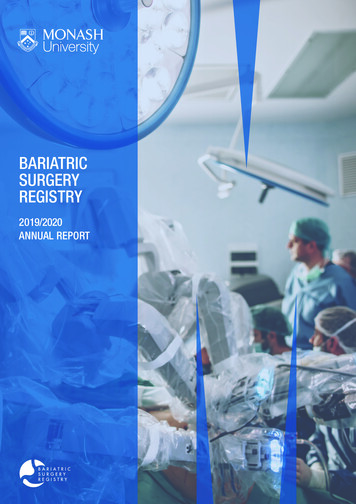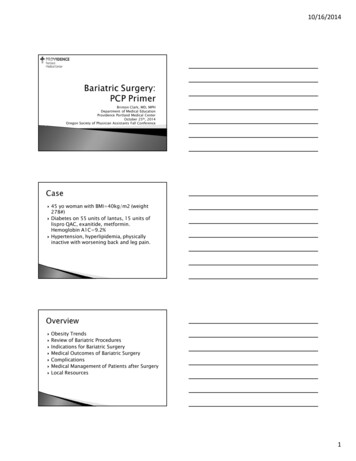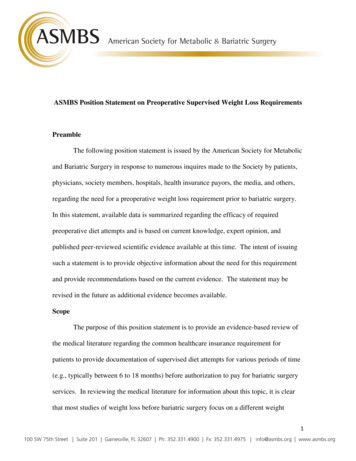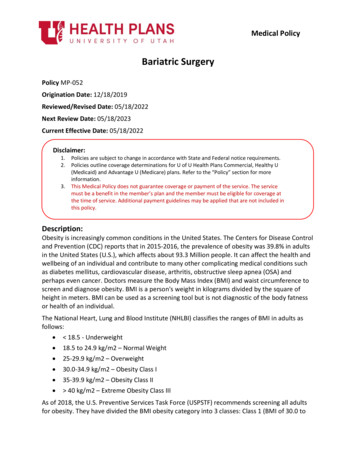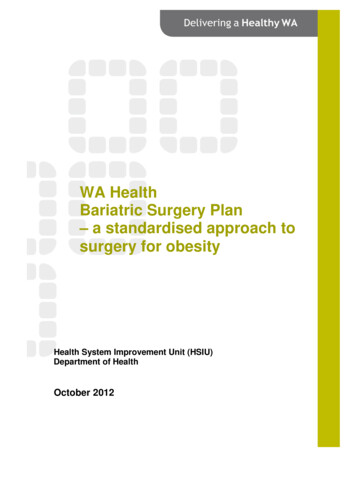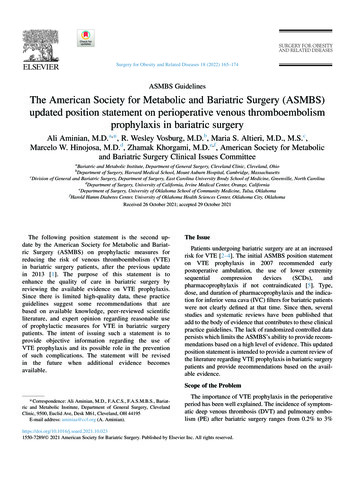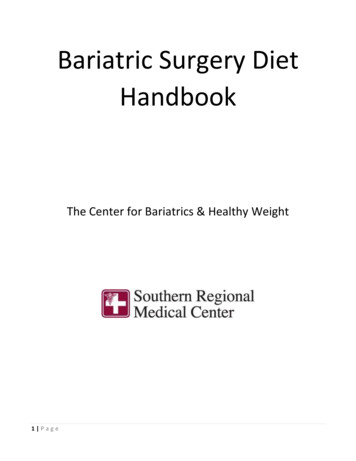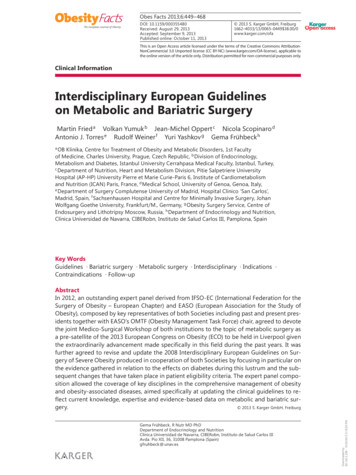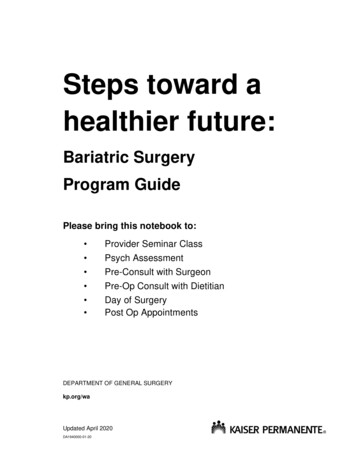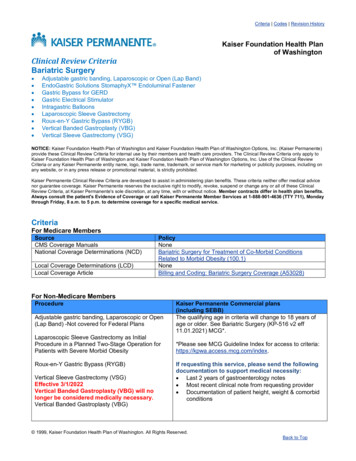
Transcription
Criteria Codes Revision HistoryKaiser Foundation Health Planof WashingtonClinical Review CriteriaBariatric Surgery Adjustable gastric banding, Laparoscopic or Open (Lap Band)EndoGastric Solutions StomaphyX Endoluminal FastenerGastric Bypass for GERDGastric Electrical StimulatorIntragastric BalloonsLaparoscopic Sleeve GastrectomyRoux-en-Y Gastric Bypass (RYGB)Vertical Banded Gastroplasty (VBG)Vertical Sleeve Gastrectomy (VSG)NOTICE: Kaiser Foundation Health Plan of Washington and Kaiser Foundation Health Plan of Washington Options, Inc. (Kaiser Permanente)provide these Clinical Review Criteria for internal use by their members and health care providers. The Clinical Review Criteria only apply toKaiser Foundation Health Plan of Washington and Kaiser Foundation Health Plan of Washington Options, Inc. Use of the Clinical ReviewCriteria or any Kaiser Permanente entity name, logo, trade name, trademark, or service mark for marketing or publicity purposes, including onany website, or in any press release or promotional material, is strictly prohibited.Kaiser Permanente Clinical Review Criteria are developed to assist in administering plan benefits. These criteria neither offer medical advicenor guarantee coverage. Kaiser Permanente reserves the exclusive right to modify, revoke, suspend or change any or all of these ClinicalReview Criteria, at Kaiser Permanente's sole discretion, at any time, with or without notice. Member contracts differ in health plan benefits.Always consult the patient's Evidence of Coverage or call Kaiser Permanente Member Services at 1-888-901-4636 (TTY 711), Mondaythrough Friday, 8 a.m. to 5 p.m. to determine coverage for a specific medical service.CriteriaFor Medicare MembersSourceCMS Coverage ManualsNational Coverage Determinations (NCD)Local Coverage Determinations (LCD)Local Coverage ArticlePolicyNoneBariatric Surgery for Treatment of Co-Morbid ConditionsRelated to Morbid Obesity (100.1)NoneBilling and Coding: Bariatric Surgery Coverage (A53028)For Non-Medicare MembersProcedureAdjustable gastric banding, Laparoscopic or Open(Lap Band) -Not covered for Federal PlansLaparoscopic Sleeve Gastrectomy as InitialProcedure in a Planned Two-Stage Operation forPatients with Severe Morbid ObesityRoux-en-Y Gastric Bypass (RYGB)Vertical Sleeve Gastrectomy (VSG)Effective 3/1/2022Vertical Banded Gastroplasty (VBG) will nolonger be considered medically necessary.Vertical Banded Gastroplasty (VBG)Kaiser Permanente Commercial plans(including SEBB)The qualifying age in criteria will change to 18 years ofage or older. See Bariatric Surgery (KP-516 v2 eff11.01.2021) MCG*.*Please see MCG Guideline Index for access to criteria:https://kpwa.access.mcg.com/index.If requesting this service, please send the followingdocumentation to support medical necessity: Last 2 years of gastroenterology notes Most recent clinical note from requesting provider Documentation of patient height, weight & comorbidconditions 1999, Kaiser Foundation Health Plan of Washington. All Rights Reserved.Back to Top
Criteria Codes Revision HistoryProcedureEndoGastric Solutions StomaphyX EndoluminalFastenerGastric Bypass for GERDGastric Electrical Stimulation (GES) for ObesityIntragastric Balloon DeviceKaiser Permanente Commercial plans(including SEBB)There is insufficient evidence in the published medicalliterature to show that this service/therapy is as safe asstandard services/therapies and/or provides better longterm outcomes than current standard services/therapies.If requesting review for these services, please sendthe following documentation: Last 6 months of clinical notes from requestingprovider &/or specialistMCG* A-0970This is not covered per MCGIf requesting review for these services, please sendthe following documentation: Last 6 months of clinical notes from requestingprovider &/or specialist*Please see MCG Guideline Index for access to criteria:https://kpwa.access.mcg.com/index.The following procedures are not covered (benefits are varied and need to be verified): Biliopancreatic bypass,Distal gastric bypass, Duodenal switch (Single-Anastomosis Duodenal Switch), Mini-gastric bypass.Effective March 1, 2022The vertical banded gastroplasty (VBG) is no longer a standard of care and is therefore considered not medicallynecessary and not covered.CDC Adult Body Mass Index (BMI) Calculator View mi/adult bmi/english bmi calculator/bmi calculator.htmlPercent of Excess Body Weight Loss Formula(Initial Weight – Postop Weight)/ (Initial weight – Ideal Weight*) Ideal weight is defined by the weightcorresponding to a BMI of 25 for the person in question.*The MCG are proprietary and cannot be published and/or distributed. However, on an individual member basis, Kaiser Permanentecan share a copy of the specific criteria document used to make a utilization management decision. If one of your patients is beingreviewed using these criteria, you may request a copy of the criteria by calling the Kaiser Permanente Clinical Review staff at 1-800-2891363 or access the MCG Guideline Index using the link provided above.The following information was used in the development of this document and is provided as background only. It isprovided for historical purposes and does not necessarily reflect the most current published literature. Whensignificant new articles are published that impact treatment option, Kaiser Permanente will review as needed. Thisinformation is not to be used as coverage criteria. Please only refer to the criteria listed above for coveragedeterminations.Evidence and Source DocumentsEndoGastric SolutionsGastric Bypass for GERDGastric Electrical Stimulator for ObesityIntragastric BalloonsLaparoscopic Sleeve GastrectomyVertical Sleeve Gastrectomy (VSG)Background 1999, Kaiser Foundation Health Plan of Washington. All Rights Reserved.Back to Top
Criteria Codes Revision HistoryThe NIH has defined overweight as a BMI between 25 kg/m2 and 29.9 kg/m2, and obesity as a BMI of 30kg/m2. According to national survey data, an estimated one-third of adults in the United States are overweight.Overweight and obesity are associated with an increased risk of mortality. Individuals with a BMI 30 have a 50100% increased risk of premature death compared to individuals with a BMI between 20 and 25. In addition,overweight and obesity are associated with an increased risk of coronary heart disease, type 2 diabetes,hypertension, certain cancers and musculoskeletal disorders such as knee osteoarthritis (Surgeon General report:USPSTF).Lifestyle changes, including diet, exercise, and behavior modification, are generally considered first-line therapyfor overweight and obesity. Pharmacotherapy can be used as an adjunctive therapy when lifestyle changes aloneare ineffective. Medical management of obesity has been found to be less effective with individuals who aremorbidly obese (BMI 35) than for those with lower BMI, particularly in terms of sustained weight loss. The NIHhas stated that bariatric surgery is an option for patients with a BMI 40 or a BMI 35 with comorbid conditions,who have failed medical treatment (Fisher and Schauer, 2002; NIH, 1998).There are two main strategies for surgically inducing weight loss, gastric restriction and intestinal malabsorption.Restrictive procedures mechanically reduce the size of the stomach. This limits the amount of food a patient canconsume at a single meal and causes early satiety. Substantial dietary compliance is required, becauseindividuals are still able to consume high-calorie liquids or soft foods. Malabsorption procedures involve bypassinga portion of the intestines which decreases the proportion of nutrients that are absorbed from food. Some types ofsurgeries use elements of both strategies (Fisher and Schauer, 2002; Southern California-RAND EBPC 2004).Two currently accepted bariatric surgery methods are Vertical Banded Gastroplasty (VBG) and Roux-en-Y gastricbypass (RYGB). VBG is a restrictive procedure that uses staples to create a narrow gastric inlet or pouch and anon-adjustable band is placed around the new inlet to prevent enlargement. RYGB includes both restrictive andmalabsorptive elements. The stomach is reduced to a small gastric pouch, and this pouch is connected to asegment of the jejunum, bypassing the duodenum and proximal small intestine. RYGB can be performed as opensurgery or laparoscopically.Adjustable gastric banding is a restrictive technique, using the Lap-Band System (Inamed). A small gastricpouch is formed by laparoscopically placing a silicone ring (the Lap-Band) around the upper part of the stomachjust below the gastro-esophageal junction. The band is connected via tubing to an access port that is securedbeneath the skin of the abdomen. The band has a reservoir that is accessed percutaneously and filled with saline.The size of the band can be adjusted by adding or removing saline. The Lap-Band is removable, eitherlaparoscopically or via an open procedure. In the clinical study presented by the manufacturer to the FDA, 60% ofthe band removal procedures were laparoscopic. The Lap-Band has been used in Europe and Australia sinceearly 1990s and was approved by FDA in June 2001 (manufacturer's Web site).Medical Technology Assessment Committee (MTAC)Vertical Banded Gastroplasty (VBG) and Roux-en-Y gastric bypass (RYGB)2/10/1999: MTAC REVIEWEvidence Conclusion: The published scientific evidence consists of several large case series and onerandomized controlled trial from multiple institutions published over a 10-year period of time. Vertical BandedGastroplasty (VBG) Data from 4 case series and 1 RCT totaling 403 patients undergoing VBG with 75-100%follow up at 3 years demonstrates between 15 and 31% weight loss. Reoperation or revisional surgery wasrequired in 3% of patients in one series and 36% in another series. Mortality was 1-3% overall. Roux-en-Y (REY)Data from 2 case series and 1 RCT totaling 532 patients in the REY groups with 60-86% follow up at 3 yearsdemonstrates that Roux-en-Y gastric restrictive surgery results in between 33 and 35% weight loss. Reoperationor revisional surgery was required in 6% of patients in one series and not reported in the other series. Mortalitywas 1% overall.Articles: MacLean, LD et al. Surgery, 1993;113:380-388. See Evidence Table. Sugerman, HJ, et al. 1989: Am JSurg.;157 93-100. See Evidence Table.Sjostrom CD, Peltonen M, Wedel H, Sjostrom L. Differentiated long-term effects of intentional weight loss ondiabetes and hypertension. Hypertension 2000; 36: 20-25. See Evidence Table.The use of gastric restrictive surgery (VBG or REY) meets the Kaiser Permanente Medical TechnologyAssessment Criteria.12/8/2006: MTAC REVIEW 1999, Kaiser Foundation Health Plan of Washington. All Rights Reserved.Back to Top
Criteria Codes Revision HistoryVertical Banded Gastroplasty (VBG) and Roux-en-Y gastric bypass (RYGB)Evidence Conclusion: There is some evidence that Lap-Band surgery is more effective than optimal nonsurgical management for patients with BMI between 30-35 kg/m2 with co-morbidities. This evidence is notconclusive due to the size of the single RCT, and its limitations. Evidence from non-randomized studies suggeststhat gastric bypass surgery is more effective for weight loss than the Lap-Band technique for patients who meetstandard eligibility criteria for bariatric surgery (BMI 40 kg/m2 or 35 kg/m2 with co-morbidities) and for the subset of patients with BMI 50 kg/m2. Gastric surgery was not associated with more complications than the LapBand procedure, and studies generally found a higher reoperation rate after Lap-Band surgery. There may beresidual confounding in the non-randomized studies. There are no randomized controlled trials comparing thesafety and effectiveness of Lap-Band surgery to either gastric bypass or optimal non-surgical management foradults with BMI 35 kg/m2. There is evidence from one randomized controlled trial that Lap-Band surgery ismore effective for weight loss than a non-surgical intervention (i.e. supervised dieting, pharmacotherapy) forpatients with BMI between 30-35 kg/m2 with co-morbidities (O'Brien et al., 2005). However, in the two years offollow-up 4 of the 39 patients who received the Lap-Band experienced prolapse of the posterior gastric wall. Inaddition, limitations of the study were that it was not blinded, follow-up was only two years, and the nonsurgicalintervention was not well described beyond 6 months. The best evidence comparing the Lap-Band and Roux-enY gastric bypass comes from two non-randomized comparative studies (Weber et al., 2004; Cottam et al. 2006).Both matched patients who did and did not receive the Lap-Band according to age, sex and BMI. The Weberstudy included patients with BMI 40 kg/m2 or BMI 35 kg/m2 who had co-morbidities and the Cottam study didnot specify eligibility criteria, but mean BMI was 47 kg/m2. Both studies found significantly more weight loss at 2-3years and fewer co-morbidities in the group that underwent gastric bypass. In the Weber et al. study, the rate ofreoperation was somewhat higher in the gastric bypass group than the Lap-Band group during the first 30 days(n 7 vs. n 1), but after 30 days the rate was higher in the Lap-Band group (n 26) than the gastric bypass group(n 4). The Cottam et al. study found a slightly higher rate of major reoperation in the gastric bypass groupcompared to the Lap-Band group (8% vs. 5%), but this difference was not statistically significant. A third nonrandomized study compared the Lap-Band and laparoscopic Roux-en-Y gastric bypass in super morbidly obesepatients (BMI 50 kg/m2). Similar to the studies of patients with lower mean BMI, there was greater reduction inBMI and a higher proportion of excess weight loss in patients who received gastric bypass compared to the LapBand. There appeared to be a greater reduction in co-morbidities and fewer complications in the gastric bypassgroup, but numbers were too small to accurately compare the groups in these areas. Reoperations werenecessary in 15% of the Lap-Band group and 6.5% of the gastric bypass group. In all of the non-randomizedstudies, there may be confounding variables, differences between groups that affect the outcome (such asdifferences in commitment to losing weight). A large case series conducted in Italy (n 1893) provides additionalinformation on the safety of the Lap-Band technique. Reported post-operative mortality was 1 out of 200procedures (0.5%) and was restricted to patients with preoperative cardiovascular complications. The mostcommon post-operative complications were gastric pouch dilation (5%) and tube port complications (4%). Theideal study would be a randomized controlled trial comparing long-term outcomes of gastric surgery with the LapBand and commonly accepted bariatric surgery procedures or optimal non-surgical management. Onerandomized controlled trial was identified and critically appraised. It compared the Lap-Band to non-surgicaltreatment. Five non-randomized comparative studies were identified comparing the Lap-Band to gastric bypass.One study conducted in Sweden was excluded because it compared two case series of patients treated atdifferent institutions. A second study was excluded because only preliminary findings were reported: there was60% follow-up at 1 year and 15% at 2 years. The other three studies were critically appraised. A large case seriesfrom Italy (n 1863) was also reviewed to evaluate the long-term safety of Lap-Band surgery.Articles: Evidence tables were created for the following studies: O'Brien PE, Dixon JB, Laurie C et al. Treatmentof mild to moderate obesity with laparoscopic adjustable gastric banding or an intensive medical program. AnnIntern Med 2005; 144: 625-633. See Evidence Table. Weber M, Miller MK, Bucher T. Laparoscopic gastric bypassis superior to laparoscopic gastric banding for treatment of morbid obesity. Ann Surg 2004; 240: 975-983. SeeEvidence Table. Cottam DR, Atkinson J, Anderson A et al. A case-controlled matched-pair cohort study oflaparoscopic Roux-en-Y gastric bypass and Lap-Band patients in a single US center with three-year follow-up.Obesity Surg 2006; 16: 534-540. See Evidence Table. Browne WB, Julliard K, Castro AE et al. Laparoscopicgastric bypass is superior to adjustable gastric band in super morbidly obese patients. Arch Surg 2006; 141: 683689. See Evidence Table. Angrisani L, Furbette F, Doldi SB et al. Lap-Band adjustable gastric banding system:The Italian experience with 1863 patients operated on over 6 years. Surg Endosc 2003; 17: 409-412. SeeEvidence Table.The use of adjustable gastric banding and lap-band in the treatment of obesity does not meet the KaiserPermanente Medical Technology Assessment Criteria. 1999, Kaiser Foundation Health Plan of Washington. All Rights Reserved.Back to Top
Criteria Codes Revision History12/15/2014: MTAC REVIEWVertical Banded Gastroplasty (VBG) and Roux-en-Y gastric bypass (RYGB)Evidence Conclusion: There is a lack of good quality RCTs with long-term follow-up that compared laparoscopicgastric banding versus Roux-en-Y gastric bypass or laparoscopic sleeve gastrectomy. The few published RCTswere small, with short follow-up duration, and methodological limitations. Colquitt and colleagues’ 2014systematic review and meta-analysis on surgery for morbid obesity was the last published update of previousCochrane reviews and updates on that topic conducted by the same group of authors over the last decade. Thislast August 2014 update (Evidence table 1) included RCTs on bariatric surgery published through December2013. The meta-analysis included 15 trials (N 1,180 participants) that compared different bariatric surgeryprocedures used for weight loss (seven additional trials compared surgery to non-surgical weight loss therapies).The meta-analysis had valid methodology and analysis, but the majority of the studies included had uncertain orhigh risk of bias. The overall results for the comparisons made among the three most commonly performedprocedures were as follows: Laparoscopic gastric bypass (LRYGB) vs. laparoscopic adjustable gastric banding(LAGB)The review found moderate quality evidence from 3 RCTs with uncertain risk of bias that LRYGB achievedsignificantly greater weight loss and BMI reductions up to 5 years after surgery vs. LAGB. Two trials reportedlonger duration of hospitalization with LRYGB, and one study showed that it was associated with larger number oflate major complications vs. LAGB. On the other hand, one study showed that a large proportion of thoseundergoing LAGB required reoperation for band removal (the authors warned against generalizability of results ofthis study due to high drop-out rates). The evidence on QoL and co-morbidities was of very low quality. LAGB vslaparoscopic sleeve gastrectomy (LSG) One relatively small study (Himpens et al, 2006) with methodologicallimitations (reviewed earlier by MTAC) showed that reductions in weight and BMI were statistically significantlyhigher with LSG vs LABG. The study also showed that symptoms of GERD were resolved in a higher proportionamong patients in the LSG group vs. LAGB (no tests of significance were provided). Open or LRYGB vs. LSGThe RCTs included showed no statistically significant differences between the two procedures in the reductions inweight or BMI. Serious adverse events were reported in one trial and were higher in the LRYGB group. Therewere no statistically significant differences between the 2 procedures in their effect on comorbidities andcomplications except for one study that showed significantly more improvement in diabetes mellitus with LRYGB.The authors of the review concluded that the outcomes were similar between RYGB and LSG and that bothprocedures had better outcomes than LAGB. There was no good evidence from RCTs to determine whether anyprocedure was more effective than another in controlling comorbidities. The studies had relatively short-termfollow-up durations, which was insufficient to study the long-term effects of the surgical procedures.Wang et al, 2013 (Evidence table 2) conducted a meta-analysis of 11 randomised and non-randomized controlledstudies (N 1,004 participants) that compared LAGB with LSG. The pooled results suggest that LSG is associatedwith greater excess with loss (EWL% mean difference -12.55 [95% CI, -15.66, -9.43] at 6 months and -4.97 [95%CI, -7.58, -2.36] at 12 months). LSG was also associated with better improvement in type 2 DM than LAGB(pooled OR of 0.34; 95 % CI 0.16-0.73). The meta-analysis combined the results of a small number ofrandomized and non-randomized studies with small sample sizes and short-term follow-up durations. The authorsconcluded that larger RCTs with long-term follow-up are needed to compare the efficacy of LSG, LAGB, andLRYGB.Dogan and colleagues (2014) compared the safety and effectiveness of LAGB, LRYGB, and LSG in a matchedretrospective cohort study involving 735 patients who underwent the procedures in two centers in the Netherlandsbetween 2007 and 2010. The results showed that LRYGB was associated with a significantly higher excessweight loss compared to LSG in the first year after which there was no significant difference in weight lossbetween the two procedures. After 3 years of follow-up LAGB had a higher complication rate compared to theother two procedures. Revision surgery was needed in 21% of LAGB, and 9% of LSG underwent conversion toRYGB. The authors concluded that LRYGB is a safe and effective treatment in morbidly obese patients with goodlong-term outcomes. LSG was comparable to LRYGB regarding weight loss and complication rate; and that LAGBwas inferior to both LRYGB and LSG. Arterburn, et al (2014) compared the short and long-term outcomes ofLRYGB and LAGB in a retrospective cohort study of 7,457 adult patients who underwent laparoscopic bariatricsurgery from January 2005 through December 2009 in 10 health care systems (including Kaiser Permanente) inthe US. 1,507 underwent LAGB and 5,950 underwent RYGB. The primary outcomes were change in BMI,composite of 30-day rate of major adverse outcomes, subsequent hospitalization, and subsequent intervention.The results indicate that RYGB led to a significantly greater loss in BMI than LAGB (14.8 loss with RYGB vs. 8.0LAGB, p 0.001). RYGB was associated with a higher rate of short-term complication, and long-term subsequenthospitalization. LAGB on the other hand was associated with a higher risk of long-term subsequent interventionsprocedures. The study was large and included a diverse group of patients but was retrospective and notrandomized. Data were obtained from records which did not included all required information, and the subsequentinterventions and hospitalizations may have been due to causes unrelated to the bariatric procedures. Trastulli et 1999, Kaiser Foundation Health Plan of Washington. All Rights Reserved.Back to Top
Criteria Codes Revision Historyal (2013) conducted a systematic review to evaluate the safety and effectiveness of LSG in terms of weight loss,comorbidity remission, and efficacy for the management of patients with type 2 diabetes mellitus. The reviewincluded 15 RCTs, 6 of which compared LSG with LGB and 2 vs. LAGB. Three of these studies were judged bythe authors to have good quality and the rest were of fair quality. The authors could not perform a meta-analysisdue to the heterogeneity of the studies but performed some cumulative analyses when suitable. The results ofthese analyses indicate that the complication rate was 12.1% (range 10-32%) with LSG vs. a mean of 20.9%(range 10-26.4%) with LGB. Only two trials compared LSG with LAGB, one reported 0% hospital morbidity forboth procedures, and the other (Himpens 2006) a total of 7 (17.5%) complications with LAGB (all were late) vs. 2(5%) complications with SLG (all were postoperative). The percentage of excess weight loss (%EWL) rangedfrom 49% to 81% in the LSG group, 62.1% to 94.4% in the LGB group, and 28.7%-48% in the LAGB group) in afollow-up duration ranging from 3 months to 3 years. Type 2 DM remission ranged from 26.5% to 75% with LSGand 42%-93% with LGB. Buchwald and colleagues (2009) performed a systematic review and meta-analysis of621 experimental and observational studies (N 136,134 participants) on bariatric surgery that were published inEnglish between 1990- 2006, and that reported on the resolution of type 2 diabetes. Nineteen studies with 43treatment arms and 11,175 patients reported on both weight loss and diabetes resolution separately for diabeticpatients (N 4,070). The analysis indicated that overall, 78.1% of diabetic patients had complete resolution, anddiabetes was improved or resolved in 86.6% of patients. Weight loss and diabetes resolution were greatest forpatients undergoing biliopancreatic diversion/duodenal switch, followed by gastric bypass, and least for bandingprocedures. Insulin levels declined significantly postoperatively, as did hemoglobin A1C and fasting glucosevalues. Conclusion: The limited published evidence comparing LAGB to LRYGB or LSG suggest that LAGB is notthe most effective surgical procedure for the morbidly obese patients. The literature indicates that LAGB mayhave shorter operative time, shorter length of hospital stays, and lower rate of early complications; but it is alsoassociated with higher rates of late complications and risk of surgical interventions compared to other bariatricsurgery procedures. There is no good published quality evidence to date, to determine the comparativeeffectiveness of LAGB to LSG or LRYGB on the resolution of co-morbidities and improvement of health-relatedquality of life.Articles: The literature search for studies published after the 2006 MTAC review, revealed over 500 publications,many of which were unrelated to the current review. Very few small randomized controlled trials compared theeffects of one surgical bariatric procedure versus another. The search identified a recently updated Cochranereview (Colquitt et al, 2014) on surgery for weight loss in adults; a meta-analysis that compared LAGB with LSG(Wang et al, 2013), a multicenter retrospective matched cohort study (Dogan et al, 2014) that compared gastricbypass, LAGB and LSG in morbidly obese patients; three systematic reviews with no meta-analyses of RCTs onbariatric surgeries; a comparative effectiveness study of laparoscopic adjustable gastric banding vs. laparoscopicgastric bypass; as well as several cohort studies with no control or comparison groups that reported on short andlong-term outcomes of gastric banding and LSG procedures. The two most recent meta-analyses were selectedfor critical appraisal.Colquitt JL, Pickett K, Loveman E, et al. Surgery for weight loss in adults. Cochrane Database Syst Rev. 2014Aug 8;8:CD003641. DOI: 10.1002/14651858.CD003641.pub 4. See Evidence Table 1Wang S, Li P, Sun XF, et al. Comparison between laparoscopic sleeve gastrectomy and laparoscopic adjustablegastric banding for morbid obesity: a meta-analysis. Obes Surg. 2013 Jul; 23(7):980-986. See Evidence Table 2The use of LAGB in the treatment of obesity does not meet the Kaiser Permanente Medical TechnologyAssessment Criteria.EndoGastric Solutions Stomaphy X Endoluminal FastenerBACKGROUNDObesity Surgery the EndoGastric Solutions StomaphyX endoluminar fastener and delivery system is a sterile,single-use device for use in transoral tissue approximation and ligation in the GI tract. The system consists of anergonomic, flexible fastener delivery device and sterile polypropylene fastener implants. The device is introducedinto the body through the mouth under endoscopic visualization. Once inside the stomach, the stomach wall issuctioned into the tissue port on the StomaphyX creating a large plication. Non-resorbable polypropylenefasteners are then deployed across the fold to hold the tissue in place. Typically, 10 to 20 folds are requireddepending on the patient’s anatomy. The pleats created in the stomach will reduce its size, which wouldpotentially lead to early satiety and weight loss. According to the manufacturer, the StomaphyX procedure isincisionless, adjustable, and revisable. It is usually performed as an outpatient procedure, and is intended forindividuals who want an alternative to invasive weight loss surgery, or those who have had previous gastricbypass surgery and are regaining weight. The EndoGastric Solutions StomaphyX endoluminar fastener anddelivery system was cleared for marketing by the FDA in February 2007 for use in endoluminal trans-oral tissueapproximation and ligation in the GI tract. The InScope Tissue Apposition System is a sterile, single patient 1999, Kaiser Foundation Health Plan of Washington. All Rights Reserved.Back to Top
Criteria Codes Revision Historyused disposable suture system for approximating and securing soft tissue within the gastrointestinal tract. It isintended to perform suturing in conjunction with endoscopes having a working channel of 2.8 mm or larger. Thesystem can be used to treat variety of defects endoscopically including ulcers and perforations (FDA Web site).The InScope Tissue Apposition System was cleared by the FDA for marketing in January 2007 to be used forthe placement of sutures and approximation of soft tissue. GERD According to the Montreal Consensus,gastroesophageal reflux disease (GERD) is defined as a condition which develops when the reflux of stomachcontents cause troublesome symptoms and/or complications. GERD is a mechanical disorder that is caused by adefective lower esophageal sphincter, a gastric emptying disorder, or failed esophageal peristalsis. Typicalsymptoms of GERD include heartburn and regurgitation; however, overtime reflux can cause ulceration, Barrett’sesophagus, airway disease, and esophageal cancer. It is estimated that 40% of individuals in the United Statessuff
standard eligibility criteria for bariatric surgery (BMI 40 kg/m2 or 35 kg/m2 with co- morbidities) and for the sub-set of patients with BMI 50 kg/m2. Gastric surgery was not associated with more complications than the Lap-Band procedure, and studies generally found a higher reoperation rate after Lap-Band surgery. There may be


